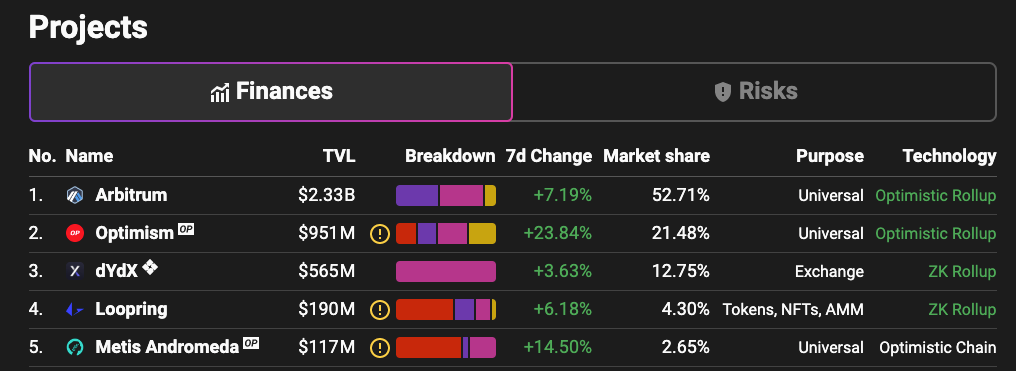Hey friends 👋
In spite of all the chaos in the world, I still fancy myself an optimist. I love how the combination of human coordination and technology can seemingly solve almost any problem 🤝
Take for example the issues the Ethereum network has faced in recent years. As a robust and secure smart contract blockchain, it has become the dominant platform for settlements, decentralized finance, and NFTs. But Ethereum’s base layer is built to put security above all else and, as such, opts for relatively small blocks 🧱
Small blocks help maintain decentralization because the nodes that store history don’t need to add massive data dumps several times per minute. This means average people, with reasonably average computers can run them. The trade-off however is, understandably, throughput.
A common visualization of this problem is that of a highway. As traffic increases, more cars (usually containing very few passengers) begin to use the road. Soon, it’s congested 🚗🚙🚗
A lot of people make the assumption that simply adding more lanes will solve the problem, but more lanes use more land, and ultimately, those lanes too fill up. Eventually you have to add more and more lanes (aka bigger and bigger blocks) until the land required is no longer feasible… then what? 🧐
We don’t see many 24 lane highways being constructed because there is a far better solution available, and it’s one that can actually solve the issue and scale without consuming the entirety of our landscape (or in the case of blockchains, our hard-drive space)…
Mass Transit

I know what you’re thinking: “what is this? Infrastructure Week?” 🤨
My friend, when it comes to designing systems, every week is infrastructure week.
So let’s go back to the analogy of highways. Let’s say that on a hypothetical strip of road, each lane can hold 100 cars, and let’s say that we have 3 lanes. Well then, we have 300 cars cruising along. But as this route becomes more popular, many more cars come, and congestion causes unbearable slowdowns, or worse, accidents 😓
We could double the lanes, yes. But then we’re only good until we hit 600 cars. Imagine if we instead put more people in each vehicle 🚌 A city transit bus can hold on average 60+ passengers in about the space of two or three cars.
If each two cars in our hypothetical scenario above was replaced with a bus containing even half of its capacity, we’d have 150 busses of 30 people each. That’s 4500 people in the same space as about 300 (most cars travel with a single passenger, but could hypothetically hold up to 4 or 5; even then, that would still be only 1200 to 1500 people) 🧠
Now, rugged individualism, fuel subsidies, and a multi-decade campaign of influence by the Koch Brothers has prevented this optimization from hitting the real highways, but fortunately the information highways operate in more logical ways. You see people want to use a secure network like Ethereum but they also want fast and affordable transactions ⚖️
Look Who Just Rolled Up
Layer 2 solutions are not a new concept. Bitcoin’s lightning network was proposed in a 2015 whitepaper and launched officially in 2018. To this day, if you want to transact on Bitcoin, this is the most cost-efficient way to do so… if that’s something people want to do… I’m skeptical it is 😉
I’ve touched on the different kinds of Layer 2 scaling solutions in other posts, so I won’t go too much into the technical differences between state-channels like Lightning and rollups, but for the curious, I definitely recommend this post by Ethereum co-founder and lead researcher, Vitalik Buterin.
For simplicities sake, let’s say that the goal of any Layer2 is to allow transactions to be batched off-chain and settled on chain. Think of this like a trust-minimized version of what Visa or Mastercard do 💳
A rollup, as the name suggests, allows transactions to be rolled up and settled as a little bundle of data to the Ethereum mainnet. There are two main variations of this technology: optimistic rollups and zk-rollups.
Zk-rollups are very interesting and certainly a subject we’ll get into in a future post but today I want to focus on the optimistic rollups as they are currently the most popular scaling solution by far.

The OGs of OP
Optimism is, as the name alludes, an optimistic rollup. It was built by a team of Ethereum developers with a rather impressive track record. Karl Floersh, the chief technology officer of the non-profit Optimism Foundation which designed the network, previously helped develop Plasma, which serves as the technological base of the popular Polygon PoS Chain. He also worked on Casper, the consensus mechanism employed on the Ethereum Proof-of-Stake network 👻
Together with fellow Plasma Group teammates, Jinglan Wang and Ben Jones, Karl co-founded Optimism. Plasma and Optimism settle transactions in a similar way, by trusting that validated transactions are correct, but providing a window of time where they can be contested before finalizing them to the Ethereum mainnet. When the results are contested, the original code is run again on the Layer 1 to confirm correctness, at which time they become final.
This assumption of correctness is the reason for the name optimistic rollups and a big part of why the team chose the name Optimism. The other reason for the name is summarized in the official docs:
…none of this would be possible without a sense of optimism. Our optimism about the Ethereum vision keeps this project moving forward. We believe in an optimistic future for Ethereum, a future where we get to redesign our relationships to the institutions that coordinate our lives.
If you watch interviews with Karl or read any of his writing, you will immediately recognize that this is not just marketing speak, but a peak into the ideology that underlies the Optimism Foundation’s design decisions.
An Increasingly Optimistic Outlook
By design, rollups are more centralized than so-called Layer 1s, but their use of Ethereum for finality removes the majority of the negative externalities from this. Because the data is available and the code can be run again—and this is especially true for Optimism which is EVM equivalent and moving towards complete Ethereum equivalency in terms of code execution—even a single validator sequencing transactions could do very little in terms of censorship.
But that’s not to say the protocol is truly decentralized. And the team at Optimism knows this, which is why they’ve begun the process of progressive decentralization 🗳
But then, you already knew that didn’t you?
Airdrop #1
You probably knew about Optimism before you even clicked on this article. Not for the reasons I’ve mentioned above but because recently, there was an airdrop 🪂
That’s right, back at the end of April, the OP token was officially announced after months of speculation, and the airdrop of tokens became available (by the way, if you haven’t already, check if you’re eligible!) 👀
That airdrop accounted for just 5% of the total token supply, a little over 1/4 of the 19% being allocated to all airdrops. So my advice to airdrop farmers is to use the network as much as you can—relative to your needs and financial capacity of course.
Update: On February 9th, 2023, OP Drop #2 took place distributing (directly, without needing to be claimed) 11.7M OP to over 300k unique addresses. More on that here.
The airdrops are not the whole story though for those looking to acquire tokens. Whether to become stewards of the platform or to benefit financially, those looking to score some free OP will also like this little detail from the official docs:
25% of initial OP token supply is allocated for Proactive Project Funding. This will be distributed via community governance, KPI-driven incentives, grants programs, and other mechanisms.
This brings me to the whole reason I’m writing this article…
PoolTogether is Live on Optimism
I like grants. In fact, I’ve received multiple grants from PoolTogether’s PoolGrants program that have helped me make content like this 🙏
If you’re unfamiliar with PoolTogether, check out my posts The New Wave of DeFi, I Joined a DAO and I Like It, and Sharing is Caring for more on what makes this crypto prize-savings protocol so special 💜
PoolTogether also likes grants. In fact, as they prepared to launch the protocol to be on its first rollup, they submitted an application for OP incentives. And the proposal was accepted! 🎉
So, what does that mean?
PoolTogether received 450,000 OP tokens to distribute to users of the protocol (people who deposit USDC into the prize-savings dApp at PoolTogether.com) on Optimism during the campaign.
According to the official announcement from PoolTogether, Phase 1 of the distribution will take place over the four weeks beginning…
…Tuesday, July 26th at 7 pm GMT.
Rewards are accrued in real-time and claimable in weekly epochs. For example, the first rewards will be claimable on August 4th at 7 pm GMT.
OP tokens will be distributed at a rate of 25,000 per week.
Throughout the campaign, the PoolTogether DAO will discuss how to operate further phases of the distribution. Expect an update to this post, as more information becomes available.
Update: OP rewards were extended to March 28th, 2023. More info here.
In the meantime you may be wondering…
How to Deposit into PoolTogether on Optimism
For those of you who are new to Optimism, PoolTogether, or both, I’ve got something special just for you: a tutorial for how to get funds onto Optimism and deposit into PoolTogether 👨🏫
And, because I know that after 1500 words about everything from highways to progressive decentralization, you’re probably sick of reading…
I made a video. Enjoy!
And until next time,
Thumbs Up
This post is brought to you thanks to a grant from PoolTogether. As always the opinions expressed are my own.
If you enjoyed this blog post, consider collecting a copy. It's like tipping and receiving a unique digital collectible as a receipt.
To become a patron and unlock special perks, like Q&A in the newsletter, you can mint my non-fungible patronage NFT on Optimism, Zora, Base, or Ethereum
And for the cypherpunks, I accept anonymous tips with Zcash to my shielded address:
zs17a2mhl6xeu56cqqeqync9kddyg8gggcy6253l5evjdyw8l8j8f60eg40exr4wk27hnvfgkkgnju

